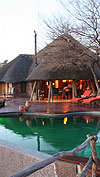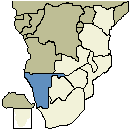Namibia
Unique rugged beauty
Quick Reference
Currency: 1 Namibia Dollar (NAD) = 100 cents
Capital: Windhoek
Time:
GMT +1 or
GMT +2 first Sunday in April to first Sunday in September
Main Languages: English, German and Oshvambo
Climate: Warm and dry north to humid coastal south. Temperate inland.
Electricity: 220 volts, 50Hz. Round three-pin plugs

Safari Tours

Accommodation
Namibia is a country rich in natural resources. Visitors can enjoy its unique rugged and barren beauty with desert landscapes, sunshine and wildlife.
It has a diversity of natural habitats: the rugged coastline and haunting beauty of the Skeleton Coast, the endless stretch of undulating ochre-coloured sand dunes at Sossusvlei, the impressive gorge of the Fish River Canyon winding through the arid landscape of the great plateau, and the vast salt pan of Etosha National Park, one of the world’s greatest wildlife viewing venues.
The old German colonisation is evident in the language, food and architecture, particularly in the capital city of Windhoek.
The indigenous tribes tried vigorously to retain their independence, and in 1904 a major uprising by the Herero and Nama people resulted in massive genocide retaliation by the colonialists, with an estimated 60 percent of the native population in the south being wiped out. Today the population consists of 11 main ethnic groups.
The best time to travel to Namibia is during the winter, between March and October.
Currency
1 Namibia Dollar (NAD) = 100 cents. Its value is equal to the South African Rand, which is also accepted as legal currency in Namibia. Major credit cards are accepted. Travelers cheques and foreign currency can be exchanged at any bank or bureau de change, though cash is more expensive to exchange than Travelers cheques. ATMs are available in larger towns only.
Health
A yellow fever certificate is required for all Travelers arriving from infected areas. Vaccinations for Hepatitis A and typhoid fever are also recommended. There is currently an outbreak of polio in the country, with the majority of cases reported in the capital Windhoek; 27 people have died and many others are affected. Travelers should ensure their polio vaccination is up to date. There is a malaria risk in the northern region during the rainy season, from January to April. HIV/AIDS is prevalent and cautions are essential. There has been an increase in the incidence of rabies among dogs in Windhoek. There are good medical facilities in Windhoek, but medical insurance is essential as treatment is expensive. Travelers to Namibia should take medical advice at least four weeks prior to departure.
Language
English is the official language, but many people also speak Afrikaans and German. There are also several indigenous languages spoken, mainly in the rural areas.
Tipping
Tips of 10% are expected by tourist-orientated establishments where a service charge has not been included in the bill. Tour guides, game rangers and trackers rely on tips for their income, but these are discretionary and depend on good service.
Geography and Climate
The best time to travel to Namibia is during the winter, between March and October, when the weather is warm and dry, although nights can be very cold, especially in the desert. The dry season is also best for game viewing, as animals gather at waterholes and are easier to find. Summers in Namibia are very hot, particularly in the desert which can be dangerously sweltering. Thunderstorms can be expected in the summer, between November and February, and fog often blankets the coastal areas.
Religion
A large portion of the population are Protestant and Roman Catholic with a minority following indigenous beliefs and Islam. People enjoy freedom of religion.
Entry Requirements
All visitors require a passport valid for at least six months after the period of their intended stay, and documents for return or onward travel. Passports should have at least two pages free for endorsements.
Internal Transport
Travel within the country can be conducted by road on good tar surfaces between major centres. For access to wilderness areas. air charter flights are the most convenient, or, in the case of very remote sites, 4X4 vehicles.





